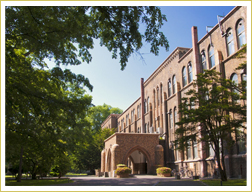Overview
 Hokkaido University is home to some 4 million specimens and documents that have been gathered, preserved, and studied since the Sapporo Agricultural College began more than 130 years ago. Amongst these are more than 10,000 precious “type specimens” that form the basis for the discovery and certification of new species.
Hokkaido University is home to some 4 million specimens and documents that have been gathered, preserved, and studied since the Sapporo Agricultural College began more than 130 years ago. Amongst these are more than 10,000 precious “type specimens” that form the basis for the discovery and certification of new species.
Opened in the spring of 1999, the Hokkaido University Museum conveys the diverse range of research carried out at Hokkaido University while also using various original materials and visual media to introduce the university’s cutting-edge research. The Hokkaido University Museum offers exhibits and diversified information equal to those of any museum, facilitating conversation and creating an atmosphere that encompasses both past and future. Visitors to the museum can shift their attention at will, examining what intrigues them most and gathering information behind the individual exhibits, thus expanding their universe.
The Hokkaido University Museum, the Museum Meister educational program, the Para-Taxonomist training for specialists working in the areas of specimen materials, and other programs that help support the University’s general education mission offer a uniquely forward-thinking educational experience. The Museum also offers great volunteer opportunities in areas such as arranging specimens and creating exhibition narratives. Open to the public, not just students and teaching staff, the Hokkaido University Museum strives to be a place where exhibits, information, and people can come together to enhance the learning process.
Mission
- To store and arrange scientific specimens and academic resources, providing for and passing on information to the next generation
- To develop interdisciplinary research areas that utilize scientific materials and methods
- To create educational opportunities and activities through exhibitions, seminars, and other media
- To create and disseminate a positive museum culture
Objectives
- Working to protect against the loss and deterioration of some 4 million important scientific specimens and academic resources, materials, works of art, and other relics that , university researchers will arrange and preserve the Museum’s collections and make them available to researchers from Hokkaido University and elsewhere (for research exhibitions), while also making a portion available to the general public.
- Treating the entire University campus as a museum containing many relics and historically significant structures, as well as a wealth of natural beauty, the Museum will serve as a gateway for visitors to the University.
- The Museum will act as a hub for disseminating the University’s academic information, conveying the results and progress of research and education.
- Using historical artifacts and materials, the Museum will introduce the spirit of Hokkaido University, which has been described as the birthplace of modern-day Japan.
- The Museum will present to Hokkaido University students the spirit and rich research traditions that are so fundamentally connected with the university, pointing out possibilities for the future. It will offer these students a chance to recognize how fortunate they are to be able to study at the University, and will contribute to the development of a positive all-around educational experience.
- The Museum will contribute to the general education and cultural fulfillment of the local community, including elementary, middle, and high school students and others, through exhibitions, excursions, lectures, concerts, and similar events.

